Introducting PLACE
PLACE is an extended performance for voices, bodies, instruments, and electronics in an outdoor environment. Composed by David Dunn in 1975 and premiered by Null Point in 2017, the piece is a continuous, ordered sequence of ten performative sound installations to be realized over the course of a day. As the piece’s title suggests, the chosen performance location generates its content: the selected site functions not as a passive backdrop for an otherwise closed work, but as an active impetus for open-ended processes of sound-making and listening.
Over the course of ten parts, the piece proceeds from mirroring the sonic environment to resonating the physical environment, moving in a gradual, circuitous, non-teleological transition. The performance begins by recording and playing back ambient sounds (part 1), proceeds to subject ambient sound to increasing transformation (re-recording recordings in parts 3 and 4, then ring modulation in part 5), imitates selected ambient sounds with voices, bodies, electronics, and instruments (parts 2, 6, 7, and 9), triggers resonances with voices (parts 7 and 8), and finally brings instruments into physical contact with materials found on site (part 10). Two large-scale tendencies result from this process. First, performed sounds gradually become autonomous from the sonic environment, as subtle inflections (parts 1-3) give way to distinctive gestures (parts 7, 8, and 10). Second, performers’ processes of sound production become increasingly linked to the physical environment, as advanced audio technology (parts 1 and 3-6) leads to voices and acoustic instruments (parts 2 and 7-10) and then to dirt, water, and detritus (part 10), in a sort of reverse history of musical technology.
PLACE attempts to cultivate a holistic, location-attuned approach to listening, embracing any and all sounds audible in a particular outdoor site. As such, this global mode of listening is a reversal of focal modes of listening associated with language as well as historical Western art music.1 If language and (Western) music encourage hearing in portrait perspective, PLACE facilitates hearing in landscape. Portrait listening emphasizes sequential processing of a single stream of content, often presuming that listeners will not only perceive but actively comprehend successive events in time, extrapolating from past content to predict (if only subconsciously) future content. This dramaturgy of expectation and realization—particularly as cultivated in the directional syntaxes of post-1600 Western art music—tends to elicit heightened focus upon a single stream of syntax, to the exclusion of all else.2 This emphasis is undoubtedly part of the reason why Western art music tends to be presented indoors in silence, often in acoustic environments expressly designed project sound sources from a limited, fixed location to the space as a whole, thereby minimizing impacts of both ambient sound and location.
In reaction to recent art music’s focal, sequential, portrait attention, Dunn’s PLACE, building on earlier work by John Cage, Maryanne Amacher, Ben Patterson, Pauline Oliveros, John Coltrane, and others, attempts to encourage a global, parallel, landscape awareness (Oliveros 1984, 185). This work might be understood as fostering an inclusive, flexible perception aimed less on detailed linear processing of a single sound stream than on continual movement towards expansive, non-hierarchical awareness. PLACE takes this mode of hearing to its logical conclusion, situating it in an open, outdoor environment: bringing landscape hearing into contact with an actual landscape. This radically reconfigures relationships between listeners and space: there is no ideal sonic clarity or “fidelity.” Nor is there an ideal volume level or balance of levels. As a result, there is no ideal acoustic space, and certainly no “best seat in the house.” Instead, a sound’s mediation by its physical and sonic surroundings is not an unwanted nuisance, but in fact becomes an integral component of the piece’s material.
A shift from focal attention to global awareness transforms experiences not only of space, but also of time. Focal perception attends to the singular time of one particular sequential syntax, while global perception observes the plurality of times perceptible in a particular location. Global awareness presupposes no ideal fixed listening location, opening up the possibility that performers and listeners might inflect their experience of the performance location’s temporal multiplicity through movement, in other words through their own times. A plurality of sound producing times are complemented by a plurality of listening times. Moreover, mobility positions performers and listeners not as passive, detached observers of the performance location, but as active participants in it. Indeed the score specifies processes of movement for performers in parts 1-4 and 6, and implies them in parts 9 and 10 (an implication pursued in Null Point’s realizations)3, while the simple, static sonic architectures of parts 1, 4, 5, and 7 might encourage listeners to be particularly mobile, as might the near-inaudibility of performed sounds of parts 2 and 9 and the dispersed sonic architecture of part 8.
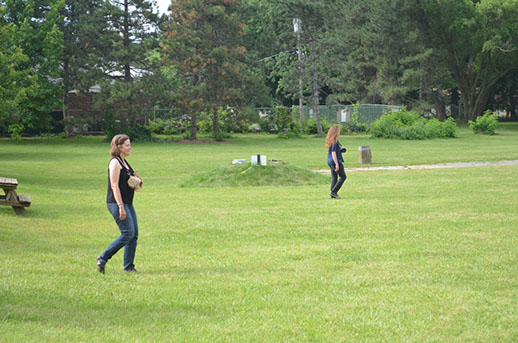
To cultivate place-specific global listening, Dunn’s piece intervenes within the performance location through two contrasting strategies:
1. Embedding acoustic “mirrors” of its sonic environment
To mirror the sonic environment, the piece reproduces ambient sounds through electronic, instrumental, vocal, and bodily means in parts 1-7 and 9. In these sections, the performance makes subtle but consequential interventions into the location’s sonic environment, introducing a nuanced play between “artificial” copies and “natural” originals. By introducing sounds that are similar but not identical to the performance location’s ambient sounds, the performance activates ambiguities between ambient and “musical” sounds, entangling them in a sonic tapestry that disorients distinctions between nature and culture. Here, sounds created by performers become meaningful not through self-contained musical “logic” but instead through collaboration and enmeshment with place-specific ambient sound.
2. Resonating its physical environment
In parts 7 and 8, voices trigger resonances, while on-site environmental materials enter into physical interaction instruments in part 10, activating and/or modifying them. The composer specifies that “resonance” encompasses any sonic phenomena resulting from performers’ “stimulus” sounds: not only echoes, reflections, and reverberations, but also the sonic reactions of living organisms.4 In these sections, the performance renders audible the materiality of the site, activating ambiguities regarding sounds’ origins. It becomes impossible to distinguish the “dry” sound produced by an autonomous human performer from its “wet” mediation in the surrounding environment. This ambiguity becomes especially pronounced in part 10, where “cultured” musical instruments and “natural” materials are enjoined in the act of making sound. In resonating the physical environment, the performance creates sounds targeted to sonify aspects of the performance location’s physical environment that might otherwise be inaudible. While stimulus sounds that may contrast quite strongly from the sonic environment, ambient sound remains a part of the piece’s material, particularly to the extent that it renders audible specific resonances and/or functions as a resonance itself in its interaction with performers’ stimulus sounds.
Together, these two strategies stage a variety of phenomenological scenarios that foreground sound’s production and dissemination within a particular location. Mirroring the sonic environment asks the question, “is this particular sound artificial or natural?” while resonating the physical environment inquires, “what parts of this sound are attributable to human performers’ action, and what parts are attributable to the environment’s mediation and/or dissemination?” In the former strategy, environment is sound producer, while human performers are sound disseminators; in the latter, the relationship is inverted. As I will explore concretely in section B below, the relationship between sound’s production and dissemination is a non-hierarchical, collaborative one: sound production gains perceptual significance to the extent that it renders audible sound dissemination, and vice-versa, in a mutual conspiracy of sonic discovery. In so doing, PLACE conjugates “cultural” and “natural” technologies of sound production and dissemination into a massive, unbounded, post-anthropocentric, location-situated meta-instrument, a cyborg technology that scrambles human exceptionalism continuously for the piece’s day-long duration. This expands upon earlier investigations of instrumental, vocal, bodily, and electronic physicalities in mid-20th-century music, sound, and performance, opening these inquiries to non-human agents and ecological issues, and in turn re-framing them as ways to suspend nature/culture binaries.
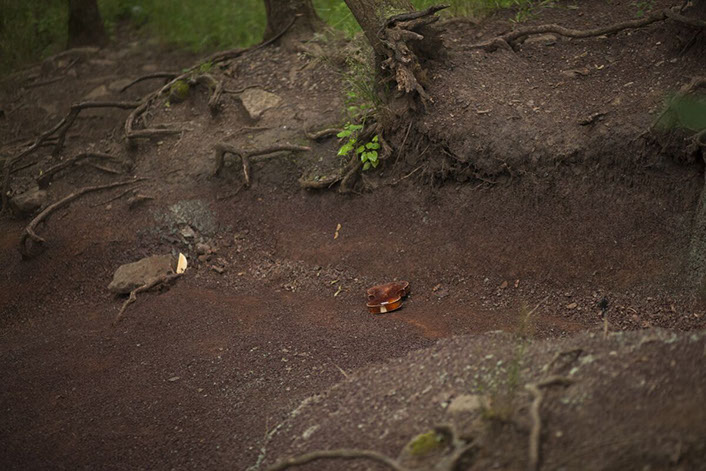
Perspectives on Location-Situated Sound
Below I will consider the dynamics of PLACE’s individual parts, exploring how they relate to the broader strategies of mirroring and resonance, and how they function to articulate large-scale processes of modulation from the former to the latter. Within PLACE’s expansive time scale, large-scale relationships recede into the perceptual background, functioning less to orient listeners than to facilitate heightened awareness of differences between contrasting location-specific sound-making strategies. In other words, the purpose of this guide is not to shoehorn location-situated sound into notions of “structural hearing,” but to provide concrete tools in the quest to listen beyond nature and culture.
Section 1
Utilize a single microphone to record the ambient sounds of the environment. Walk slowly from a central point in space, while holding the microphone, moving outward in enlarging circle motions away from the central point so as to be moving in a spiral configuration. Continue moving until a maximum distance is obtained from the central point. Playback the recorded sounds into the environment.
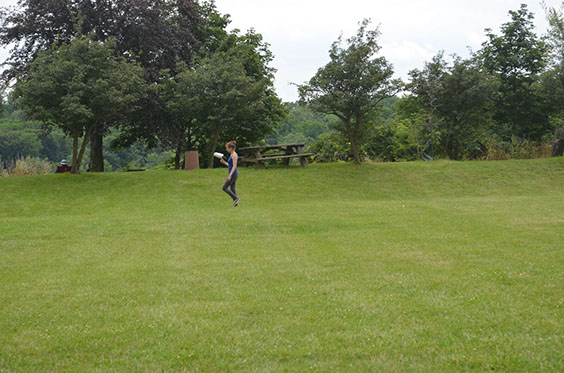
In parts 1, 3, and 4, portable recording devices and speakers record and disseminate ambient sound across space and time. Simple processes lead to complex results5: spatio-temporal relationships that might be described concisely become surprisingly multifarious and mysterious in their experiential particulars.
In part 1, a mobile recordist records ambient sound while exhaustively tracing the performance space. Playback of this recording introduces displacements of time, location, texture, and technological mediation into the sonic environment. In time, playback foregrounds how ambient sounds are perceived differently after a significant time delay. The playback also chronicles the microphone’s spatial trajectory, beginning at the speakers’ location and ending far away, introducing an additional displacement, in location.
In the domain of texture, playback functions not so much as a distinctive, self-contained addition to the existing sonic environment, but rather as a subtle thickening of it. Played back sounds oscillate in and out of plausibility as “real” ambient sounds; when especially plausible, they may become indistinguishable from ambient sound, to the point that, sonically, it may not be overtly evident that a performance is even taking place. The relationship between live and recorded ambient sound is not one of independent contrapuntal “lines” but instead is an unpredictable dance of entanglement and (slight but significant) discrepancy.
Discrepancies between live and recorded ambient sound call attention to the technological media involved: how do microphones and speakers “hear” ambient sounds differently than human ears? How do these technologies encode sound’s location compared to human ears? How do the ambient sounds change when they emanate from a single speaker rather than from multiple, often distant, locations?
Section 2
Any number of performers are to move about within a determined space. Maintain the maximum possible distance from all other performers while attempting to continually move toward the loudest sound in your vicinity. Continue to seek out new sounds. Produce sounds through use of voice and body movement which are indistinguishable from the sounds you are listening to.
While in parts 1, 3, and 4, electronics record ambient sounds and play them back after some time interval, in parts 2, 7, and 9, voices, bodies, and instruments imitate ambient sounds in real time. These different formats produce qualitatively different displacements of the sonic environment. In time, playback of recorded ambient sound invites comparisons between present and past, while real time acoustic imitation of ambient sound emphasizes contrasts between live ambient sound and reproductions of selected layers thereof.
Acoustic imitation also calls greater attention to technological mediation: not only does real-time imitation invite close attention to subtle timbral differences, but additionally, the characteristic timbres of particular voices, bodies, and instruments color their sounds relative to (often pallid, distant) ambient sounds in ways that speakers do not. In the domain of texture, real time acoustic imitation of ambient sound is (subtly) selective, highlighting sounds and sound complexes amenable to imitation by the ensemble’s particular voices, bodies, or instruments, whereas electronic recording and playback of ambient sound is indiscriminate, reproducing all frequencies audible to microphones at a given time, and therefore thickening the ambient sound texture as a whole.
Part 2 inflects acoustic imitation with spatial movement: “Maintain the maximum possible distance from all other performers while attempting to continually move toward the loudest sound in your vicinity.” As a result, this part, perhaps more than any other in PLACE, induces extreme sensitivity to sound’s location within the performance site: performers’ perception of ambient sound will vary depending on their location and direction. Extremely quiet vocal and bodily sounds—possibly audible only a short distance away—sculpt further differentiations within this nuanced sonic topography. Thus, in mirroring the sonic environment, the performance does not merely passively double the performance environment, but (re-)creates it, in close dialogue with its existing attributes.
Section 3
Record the environment for an extended period of time. Playback this recording through a single loudspeaker. Walk slowly while carrying the loudspeaker around a single omnidirectional microphone recording the playback sounding in the environment. Maintain a perimeter from the microphone which allows the recorded amplitude of the playback to match the recorded amplitude of the realtime ambience.
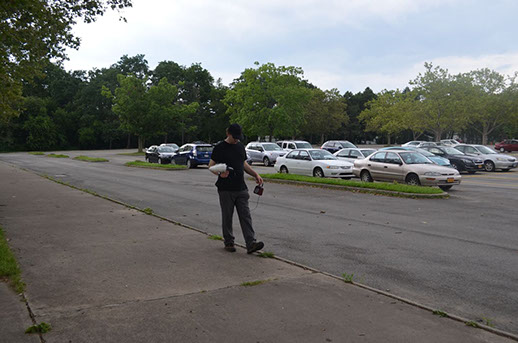
Section 4
Three or more performers are to utilize portable cassette recorders capable of playing back recorded sounds through an internal loudspeaker. Each performer is to record ambient sounds anywhere within the environmental space for any duration of time. Upon completion of recording, all performers are to move to an agreed upon central location where playback is to occur. No intentional coordination between performers should be made. After playback each performer is to move to another location to record and repeat the process, always returning to the same location for playback.
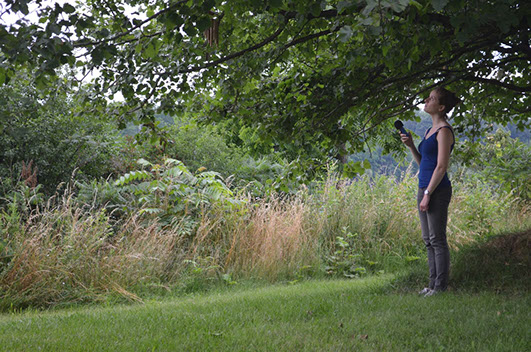
Within and between parts 1, 3, and 4, processes of recording and playback increasingly distort ambient sound to an increasing extent: the metaphorical acoustic mirrors lose their clarity. In part 1, speakers play a recording of ambient sound; in part 3, they play a recording, then a recording of a recording of ambient sound; in part 4, speakers play recordings, then recordings of recordings, then recordings of recordings of recordings, etc. If part 1 emphasizes the spatio-temporal displacements of electronic sound reproduction, part 4 emphasizes its textural and technological displacements, with part 3 functioning as a pivot between the two sections.
In parts 3 and 4, the process of recording and re-recording of ambient sound creates an increasingly dense texture, while magnifying contingencies of the recording medium. Re-recording amplifies the particularities of microphones and speakers—such as their tendency to indiscriminately pick up background noise—as well as dominant features of the site’s sonic environment. This creates an experiential paradox: within and between parts 3 and 4, playback gradually becomes acoustically distinct from ambient sound, even while being materially derived from it. Particularly in part 4, processes of re-recording create a highly distorted, thick sound mass that comes to seem unrelated to live ambient sounds. Perhaps in dialogue with contemporary pieces exploring gradual process by Alvin Lucier, James Tenney, and Steve Reich, the moment at which playback becomes autonomous from ambient sound may not be distinguishable as such, and will depend upon the listeners’ perceptual idiosyncrasy and position.
These techniques embody a radical vision of technology: recording technologies do not observe the performance environment from an “objective” distance, but directly participates in it, in a situated, non-objective fashion. Morever, the recording process’s artifacts materialize points of intersection between observer and observed, entangling audio technology—icons of technological modernity originally developed in order to master nature—with an outdoor environment.
Section 5
Place two microphones separated as far as possible within visual range of each other in an open space. Utilize the signal from microphone one as the carrier input to a ring modulator and the signal from microphone two as the program input. The output signal from the ring modulator should be amplified and heard through a single loudspeaker placed centrally at an amplitude which matches the general ambience of the environment.
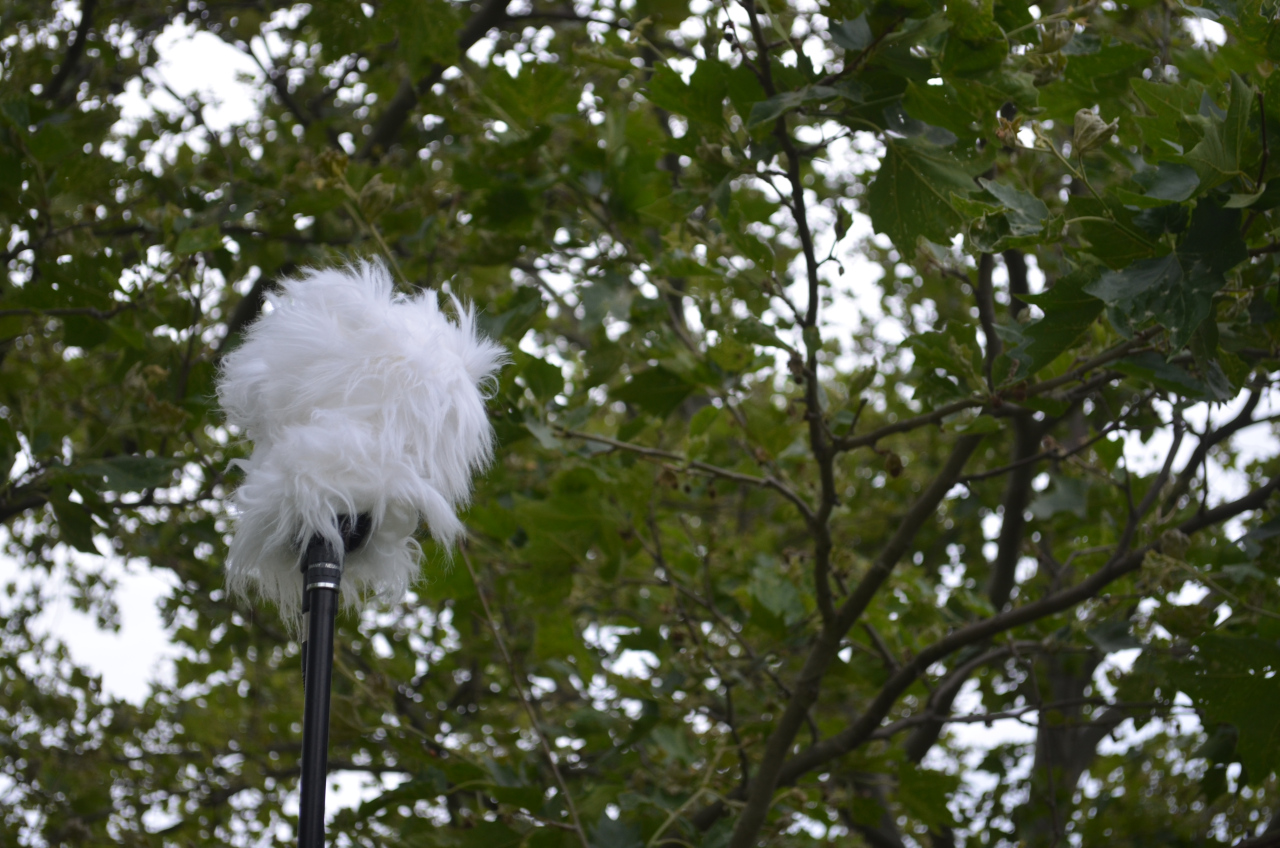
Part 5 extends first four parts’ tendency towards increasingly distorted mirroring of ambient sound. While parts 3 and 4 transform ambient sound by amplifying unforeseen byproducts of recording processes, part 5 transforms ambient sound more directly, through ring modulation. Ring modulation distorts and re-colors ambient sounds, while preserving their overall sonic contour and rhythm.
While part 5 continues this particular tendency of parts 1-4, it breaks with these sections’ behaviors in another way. If the playback of a mobile recording in part 1 offered a displacement in time, then a displacement in time and location, part 5 explores the one possibility not explored there: a displacement solely in location. Ring modulation modifies the performance site’s sonic topography as microphones route distant ambient sounds into contact with each other, and into the speakers’ location.
Ring modulation actually links displacements of timbre and location: its distortions of ambient sound result from disparities in how two distant microphones hear the performance site. Ring modulation inscribes ambient sound with its location; in displacing location, ring modulation also materializes location. See elsewhere in this issue for a more extended discussion of ring modulation in PLACE and within David Dunn’s oeuvre as a whole.
Section 6
A 10K Hz squarewave and amplified white noise are to be played separately through two loudspeakers. Two performers are to each hold one of the loudspeakers while slowly walking through the environment.
If part 5 featured drastically transformed ambient sounds, part 6 features—for the first time in the piece—sounds not derived from ambient sounds. However, these sounds—an extremely high synthesized tone and broad spectrum synthetic noise—are unobtrusive and plausible in an outdoor environment, as the tone might be easily mistaken for distant mechanical noise, while the noise might be heard as wind or as any number of distant sounds. As such, this part links acoustic and electronic reproductions of ambient sound: the synthetic sounds may be heard as imitating select ambient sounds in real time like in parts 2, 7, and 9, and yet the sounds’ continuous, electronic production relates more closely to parts 1 and 3-5. Part 6 might be heard as being especially related to part 2, where the mobility of quiet performed sounds creates a situation where performed sounds fluctuate into and out of audibility and/or distinction from ambient sound.
Section 7
A solo vocalist is to sustain pitches in response to pitches heard in the environment. An attempt should be made to trigger resonances in the environment and reinforce these through the selection of pitches. Each sound should be sustained for a maximum duration determined by length of breath. The duration between vocalized sounds should be determined by the length of resonance heard after each sound produced.
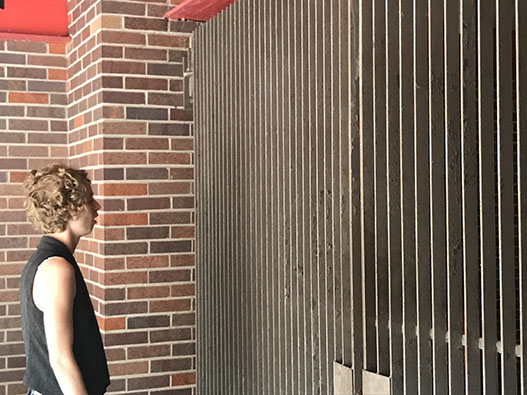
In parts 7 and 8, vocalists trigger resonances in the performance location’s inanimate environment, and possibly also in its animate environment (i.e. if a bird responds to sounds made by human vocalists). Where parts 1-7, and 9 situate human performers as resonances of the sonic environment, parts 7, 8, and 10 position human performers as instigators of resonance in the physical environment.
The resonances of parts 7 and 8 interrogate normative relationships between human musicians and their surroundings. While concert halls are designed to render audible musical sound, in PLACE, musical sound renders audible the resonances of a “found” outdoor environment. In other words, if concert halls are built to transparently amplify idealized notions of human musical sound, Dunn’s piece instead provides ways to build a sonic vocabulary that best activates points of intersection between human voice and the resonant potentials of an outdoor environment.
Part 7 functions as a pivot between PLACE’s two approaches to site-based sound. By reproducing pitches of ambient sounds while triggering resonances, part 7 functions as the crux of the transition from mirroring the sonic environment to resonating the physical environment. This cultivates two concurrent levels of acoustic ambiguity: between ambient and performed sound, and between timbral traces of performer and of physical environment, inviting listeners to change freely between these contrasting modes of listening. Voice both resonates and is resonated by the environment, in a metaphorical feedback loop.
Section 8
A group of vocalists are to produce loud non-verbal vocal sounds attempting to trigger resonances in the environment. All vocalists are to be spatially separated over a large distance within audible range of each other. Each performer may initiate a sound of their own at any time with the other vocalists responding immediately with a similar sound or responding to the resonance which the sound may create. All vocalists must decide throughout the event which action they will perform at any moment. Attention should be paid to allowing periods of silence such that resonances can be heard.
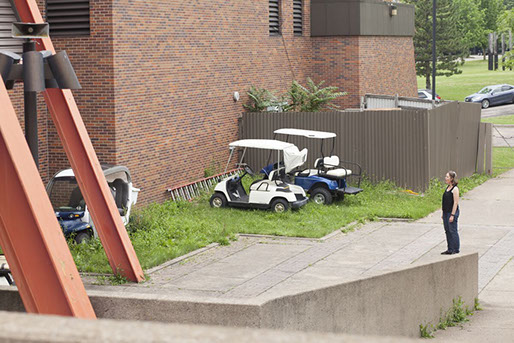
Part 8 expands part 7’s strategy of eliciting resonance, augmenting its textural density, spatial footprint, and gestural vocabulary.6 A group of spatially separated vocalists attempt to imitate each other’s sounds or resonances thereof, both mimicking and intensifying sound’s spatial and temporal dissemination. Spatial separation blurs distinctions between “dry” vocal sounds and their “wet” mediation in and by the environment, intermeshing human voice—often associated with private, humanist interiority in post-Renaissance Western culture—with environment, both inanimate and animate. Part 8’s entanglement of voice and resonance affects not only listener experience, but also performance mechanics: in reproducing each others’ sounds or resonances from a distance, vocalists inevitably magnify the physical environment’s distorting tendencies. When vocalists imitate each others’ sounds across large distances, sound moves beyond its originating location and is marked by acoustic attributes of that location.
Section 9
Any combination of instrumentalists are to produce sustained sounds in imitation of realtime events. Each player is to concentrate on one or more continuous sounds or complexes of independent sounds in the environment whose spatial and temporal characteristics are to be duplicated as closely as possible through manipulation of the instrumental sound.
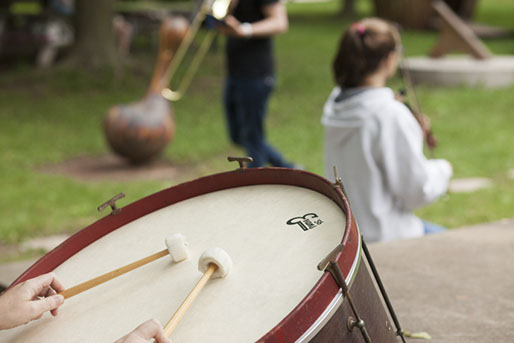
Performers imitate real-time ambient sounds with voices in part 7 and with voices and bodies in part 2, whereas in part 9, they do so with instruments. In suspending distinctions between intentional performed sound and ambient sound, the different sound sources of parts 2, 7, and 9 carry distinct cultural significations. Parts 2 and 7 situate human bodies as resonators of ambient sound, interweaving human and environment to interrogate boundaries between interior and exterior, between self and surrounding; part 9 enlists musical instruments—possibly those of “high art music”—as resonators of ambient sound, problematizing normative distinctions of social status between instruments and an outdoor environment.
Within PLACE as a whole, part 9 functions as a recapitulation of sorts—referring more to the quiet of part 2 than to the resonant loudness of part 7. This formal relationship, maybe more than any other within the piece, activates memory across long time spans, mapping a common sound making strategy onto contrasting sound sources (instruments versus voices and bodies) and onto separate ambient sound situations at contrasting times of day. Architecturally, the recapitulation of part 9 marks the end of the strategy of mirroring the sonic environment by returning to an earlier material situation. This calls attention to how much the piece has changed since its outset, and precedes the unprecedented extravagance of part 10 with an orienting, stabilizing benchmark.
Section 10
Any combination of instrumentalists are to perform a variety of physical actions in reference to the environment which result in modification of their instrumental sound. All players are to perform sounds which may be thought to alter the characteristics of the environment while taking advantage of any physical materials or properties to modify the sounds produced.
If parts 1-9 actuate sonic contact between human performers and an outdoor environment through the gas medium of air, part 10 literally solidifies this contact, cultivating direct physical connections between sound sources of (potentially) multiple material states: solid (for instance, instrument, sticks, rocks), liquid (water), and gas (air blown out of the bell of a wind instrument, air activated sonically by moving an instrument quickly). Parts 1 and 2 activate a limit situation by maximizing performers’ sonic proximity to the performance location, while part 10 embodies a complementary space by optimizing performers’ physical proximity to it.
Part 10 thus dramatically escalates part 9’s challenge to musical instruments’ perceived social refinement by physically and sonically entwining them with their “dirty” surroundings. In part 10, instruments acquire significance not by effacing their “natural” origins, but precisely through engagement with these origins, for instance when a violin is activated by a found wooden stick. The goal here is not to damage instruments, but rather to celebrate the sonic and semantic spark that emerges from the encounter between instruments and detritus, materials from opposite ends of the nature-culture continuum.
1This distinction was theorized at length by Dunn’s mentor Pauline Oliveros in Oliveros 1984, pp. 139-141 and 185-188 and Oliveros 2005, pp. 13-16.
2Here, I am defining “syntax” as a hierarchy of expectation wherein specific future outcomes are more likely than others.
3In personal communication, the composer suggests performer mobility as a general possibility during part 9 (Dunn 2017b) and suggests, as a way to end part 10 (and end the piece as a whole) that performers disperse in space until inaudible to listeners (Dunn 2017a).
4Dunn 2016.
5This formulation paraphrases minimalist/Fluxus sculptor Robert Morris’s oft-quoted statement that “simplicity of shape does not necessarily equate with simplicity of experience” (Morris, 1966, p. 44).
6Where part 7 focuses on sustained tones, part 8 embraces any “loud non-verbal vocal sounds.”
Works Cited
Dunn, David. Personal Interview. 7 April 2017.
Dunn, David. Message to the author. 5 June 2017. E-mail.
Dunn, David. Message to the author. 29 August 2016. E-mail.
Morris, Robert. “Notes on Sculpture, Part I.” Artforum. 4: 6 (February 1966): 42-44. Print.
Oliveros, Pauline. Software for People: Collected Writings 1963-1980. Smith Publications, 1984.
Oliveros, Pauline. Deep Listening: A Composer’s Sound Practice. iUniverse, 2005.<